Last week, national Swedish retailer Åhléns launched a poorly thought out advertising idea, claiming that the Swedish Jultomten, that is Santa Claus, is not a Swedish idea at all. Instead, they claim, he's Turkish.
The headline "A really Swedish Jul has a German tree, Dutch saffron bread, and a Turkish Santa" was embroidered on a traditional julbonad, and the bonad would be auctioned out to raise money for Stadsmissionen, a non-profit that helps people in Sweden who are poor or homeless.

The ad's claims are inaccurate, and I don't quite understand why so many are working so hard to "de-Swedify" old Swedish traditions. The Twitter account @Sweden claimed that the Swedish meatball is actually Turkish, which caused a stir in international press like The Guardian. Food historian Richard Tellström says that this is a myth, plain and simple, and he compares what Sweden's official Twitter account did to "Russian Troll Factories, spreading fake news."
As soon as Åhléns posted their julbonad for auction, their phone rang off the hook as people questioned the statement. Daniel Sjöberg at Allmogen, a project that aims to preserve and teach about the history and cultural heritage of Sweden, did some fact-checking. His conclusion: the ad headline is completely false.
Åhléns have stated that they mean that our Swedish "tomte" is inspired by the Catholic Saint Nicholas of Myra, which makes their headline worse as he was Greek, not Turkish, and Daniel lays out the details of that in his post. He continues:
There is no disagreement among folklore researchers that our modern Swedish "Tomte" is a mix of many different traditions and figures originating in our own Nordic people's faith and abroad.
From abroad, we have influences from the Saint Nicholas of Myra, and of course America's big-bellied Santa Claus, popularized by Coca-Cola's advertising that has spread across the world since the 1920s. To my surprise, I have now learned that Coca-Cola's world-renowned "tomte" as we know it today was created in the 1930s by Swedish-speaking Haddon Sundblom, who had a Swedish mother and a father from Åland.
Our own Swedish tomte then? Yes, it belongs to the peasantry old people's faith about the little farmer-tomte, or Nissen that is found among the Germanic peoples.
Literally "tomte" stems from the word for plot of land, every farmhouse has this small man hiding in the shadows helping take care of the farm. A gnome. Every Christmas I would leave a bowl of porridge out for him as per tradition, and my grandfather would sneak out and empty the bowl, keeping my faith in "tomten" alive.
The fact that the supersticious belief in "tomtar" is old in Sweden is known from the oldest evidence of the word tomte. It comes from a revelation of Sacred Birgitta (1303-1373) where she talks about tompt godhi. The people "worship and honor the idols, and do not go to church," she complains. The oldest evidence of our Nordic empire is thus a historical testimony of the 13th century on the Christian combat of the ancient peoples.
The connection between our little farmhouse tomte and the Christmas-gift bearing Santa Claus we know today occurred in the late 1800s, and we can largely thank the author Viktor Rydberg (1828-1895) and the illustrator Jenny Nyström (1854-1946) for that.
Rydberg's very popular children's book "Lille Vigg's Christmas Eve" was published for the first time in 1871 with illustrations by the then 17-year-old Jenny Nyström. Rydberg's poem "Tomten" from 1881 further contributed to the image of the Swedish Santa Claus, together with Jenny Nyström's warm illustrations of Swedish Christmas celebrations with "tomtar", Christmas goats, happy children and Christmas trees.
Goats? Oh yes, you see Tomten obviously brings presents on a goat pulled sleigh, or sometimes the goat himself brings the gifts! And we Swedes build a giant goat every year just to try and set fire to it before Christmas. Our traditions are complicated.
The familiar image of the jovial Coca-Cola Santa Clause, popularized around the world was originally created by Michigan-born illustrator Haddon Sundblom. Yes, Sundblom, who had a Swedish mother and a father from Åland.


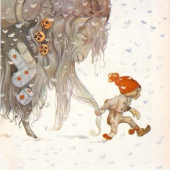
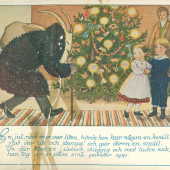
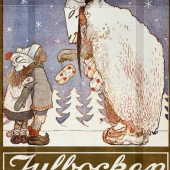

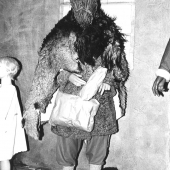
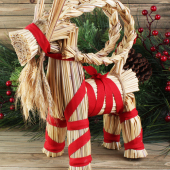
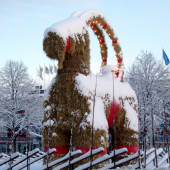
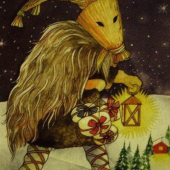
The goat is similar to that creepy alpine goatman Krampus, in that he asks if there are "any good children" in the house and if they all are, they get gifts. But if they are not, he might take them away. Much like the Dutch tradition with Swarte Piet, who may kidnap bad children to Spain. The goat was the opposite of the kind tomte, but evolved into a fun mischievous character like Zwarte Piet, but eventually, the goat's role was swallowed up by tomten himself. Still, to this day we have goats made of straw around our tree every winter. It may not be made of the farm's last harvest so it's no longer useful as a real fertility ritual, but the tradition has deep pagan roots.
Daniel Sjöberg att Allmogen also notes that Tomten has a lot of traits the old Nordic god Odin has, and even North America's source for all things Swedish has noted this connection. A reminder that it is Thor who has a carriage pulled by the goats Tanngnjost och Tanngrisner, Odin has an eight-legged horse named Sleipnir. Modern Santa has eight reindeers pulling his sleigh. Coincidence? I think not.

So what about the saffron bread depicted above? Is it really a Dutch thing? Daniel Sjöberg att Allmogen notes that despite saffron being a spice in Swedish culinary arts since the 1300s, adding to bread is a newer phenomenon. Bread itself however, has always been an important part of Swedish Christmas traditions, and the common s-shape we all know and love has been around since, well, forever. It's not an S, it's actually a little pig he explains.
Why bake bread in the shape of a pig? The pig has a prominent place in the Jul-celebrations, and then as a sacrificial animal. The Hervarar saga ok Heiðreks, tell us how King Heidrek celebrates jul, and how he leads a pig that was going to be sacrificed to the god of Fertility Frej later in the midwinter party. Folklore researcher Arvid August Afzelius (1785-1871) found traces of this sacrificial animal still among all the farmers of his time in the early 1800s.
Afzelius notes that in remote areas in Sweden they had the tradition of baking a "jul galt", which was to be preserved until the first spring days. It was thus a big breadcake that replaced the living pig not something that resembles the lusskatt of modern times. The Julbread, or seed cake, was given to the farm animals, was eaten by the head of the household and the farmer hands during the spring work, and it was mixed into the seed to give power and good harvest.
What about the "julgran", a.k.a. Christmas tree then? Is that Swedish then? Or German? Daniel at Allmogen notes that bringing a pine tree into the house is a well-documented tradition in Germany since the 1600s. But, not so fast!
However, Martin P: N Nilsson points out in his dissertation about Christmas that it is very likely "that it basically relates to the Nordic outdoor Christmas tree." Before bringing in the tree in Sweden, there was therefore already the tradition of having a "Jul" tree outdoors. Folklore researcher Hilding Celander also tells how the farmers of Western Sweden and Western Norway in Norway brought in pine branches that hung up on the walls of the home. Celander notes the similarity to the midsummer tradition when where one would decorate the inside of the home with leafy branches.
Daniel then concludes that what Åhléns is doing here isn't just wrong, it's akin to history revisionism, where when their statements aren't outright false they leave out a rich history of Nordic and Germanic cultural traditions that have distilled into our goat-burning, food feasting and dancing around the tree party we have today. He suggests that people who are tired of this kind of revisionism boycott Åhléns and return any gifts bought there.

As Swedish punters reacted to the headline, Åhléns social media team had to quickly edit the copy announcing the auction of this unique "julbonad." When it originally read "unique bonad that dispels the myth about a Swedish jul", it has now changed to "unique bonad that celebrates all kinds of jul." Their swift reaction may be too little too late, as Swedes obviously take their jul celebrations very seriously. Just ask Coca-Cola who desperately try to make us drink something other than julmust every year. Or any family member who tries to sneak in a new dish or change the recipe of anything on the family "julbord" any given year. If you don't know what the julbord is, here's a beginners guide, suffice to say the North American thanksgiving pales in comparison.

Another tradition we have in Sweden is celebrating Lucia, which is shorthand for "freak out the Nobel prize winners with a super early breakfast while wearing candles in our hair," but that's a story for another time. As this article is posted on the thirteenth of December I wish you a happy Lucia.

- reply
Permalink- reply
Permalink- reply
Permalink- reply
Permalink- reply
Permalink- reply
Permalink- reply
Permalink- reply
Permalink- reply
Permalink- reply
Permalink- reply
Permalink- reply
Permalink- reply
Permalink